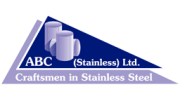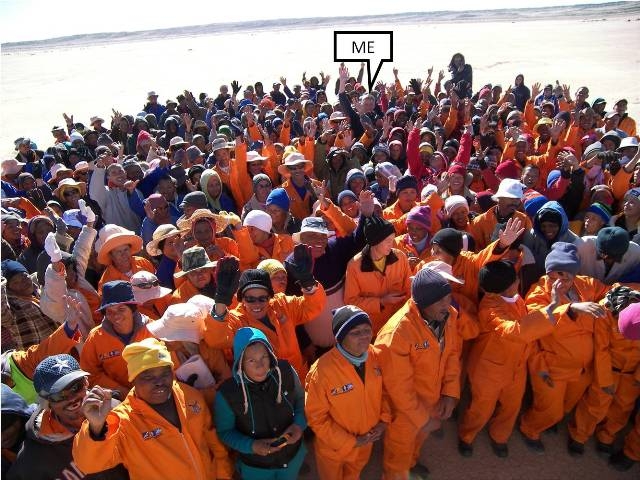
I’ve just had a very odd experience – someone’s sent me a video of myself appearing on Foreign Secretary William Hague’s Facebook page. To try and explain this rather strange event, I’ll start with my recent visit to the BLOODHOUND track in the Northern Cape of South Africa.
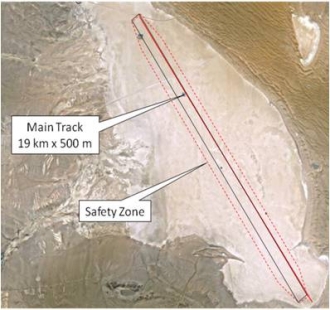 I’ve just been to inspect the work on Hakskeen Pan, in the Northern Cape, where we’ll be running BLOODHOUND SSC next year, as we test and develop the Car up to our astonishing target of 1000 mph. The scale of the work required to prepare this surface is truly vast.
I’ve just been to inspect the work on Hakskeen Pan, in the Northern Cape, where we’ll be running BLOODHOUND SSC next year, as we test and develop the Car up to our astonishing target of 1000 mph. The scale of the work required to prepare this surface is truly vast.
The Car will need to do a number of test runs, so our Main Track is 500 m wide, to give us multiple lanes to run on (each time the Car runs on the hard soil surface, its metal wheel cut ruts, so each lane is one-use-only). The Track is 12 miles (19 km) long – which is just long enough to accelerate to 1000 mph, then stop again before the desert ends. This process will only take 2 minutes, from setting off to coming to a halt 12 miles away….
In addition to the Main Track of 500 m, we need a 300 m ‘safety zone’ either side of the track, in case the Car gets very slightly off-line – because ‘slightly’ off at 1000 mph can mean being a couple of hundred metres sideways in the time it takes to correct the steering (for the sort of things that I might need to correct while I’m driving at 1000 mph, have a look at ‘How hard can it be to keep it in a straight line?’).
 The team preparing the track has to remove a huge quantity of stones from the surface – an estimated 6000 tonnes. There is no mechanical way of clearing these without damaging the surface, so it all needs to be done by hand – all 21,000,000 square metres of it! That’s the equivalent of clearing a 2-lane road, by hand, stretching from London to Moscow. This is a task of biblical proportions and would defeat us without a huge amount of help – which is exactly what we are getting from the Northern Cape Government in South Africa.
The team preparing the track has to remove a huge quantity of stones from the surface – an estimated 6000 tonnes. There is no mechanical way of clearing these without damaging the surface, so it all needs to be done by hand – all 21,000,000 square metres of it! That’s the equivalent of clearing a 2-lane road, by hand, stretching from London to Moscow. This is a task of biblical proportions and would defeat us without a huge amount of help – which is exactly what we are getting from the Northern Cape Government in South Africa.
The Northern Cape is preparing the track for us, paying a team of 300 local unemployed people (moving 6000 tonnes of stones – that’s 20 tonnes each). This will leave them as the owners of the World’s Best Race Track and is, in the meantime, bringing some much-needed employment to the area.
This team has just finished clearing the 19 km x 500 m Main Track, so I went to see how it was looking, and to spend a bit of time working with the team and thanking them for their work (you can see some more detail on how it’s looking in our latest desert update).
While I was working on the desert (and finding out just how hard and tiring the work really is), I took a short break to record a short video about the preparation work. The UK High Commission in South Africa asked for a copy – and that’s how I finished up on the Foreign Secretary’s Facebook page.
BLOODHOUND’s long-term legacy is to excite a generation of young people, through our Education Programme, about the magic of science and technology (and if your local school hasn’t already signed up to this free programme, get them to do it now!). In generating this global Engineering Adventure, of course, we’ll also be promoting British engineering on a global stage. This is exactly that sort of thing that the Government’s ‘GREAT’ campaign is trying to achieve.
I’m proud that we will be helping to promote Great (make that GREAT) British engineering – and I’m equally proud of the stunning work that the Northern Cape is doing, as they build the World’s Best Race Track. I’m still surprised to be on William Hague’s Facebook though…..
The Engineering part of our Adventure is also coming along well, and our rocket test programme is about to move into the next stage. Unfortunately I can’t give you any details (it would spoil the surprise!), but watch this space – we’ve got a cracking event planned in the not-too-distant future. Meanwhile, the tank that will contain the rocket oxidiser (high test peroxide, or HTP for short) inside BLOODHOUND SSC is completing its design, in preparation for manufacture.
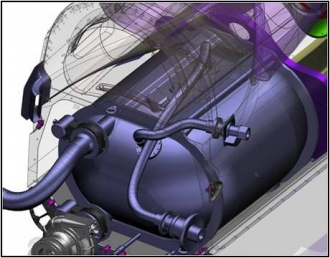 The HTP tank in BLOODHOUND
The HTP tank in BLOODHOUND
The tank will be manufactured by ABC Stainless from thin-walled stainless steel (about 2-3 mm thick) and will weigh around 80 kg. It’s going to have to carry 950 litres of HTP, weighing 1320 kg – HTP is almost pure hydrogen peroxide (H2O2), hence it’s nearly 40% heavier than water (H2O). The tank (and the rest of the Car) will have to withstand 2G of acceleration and 3G of deceleration, with an absolute limit of 9G (just in case…).
During rocket firing, the tank will feed our pump motor (the 800 hp Cosworth F1 engine) with 950 kg of HTP, which will all pumped into the rocket (at 76 Bar/1100 psi) in 20 seconds. If those numbers don’t paint a picture for you, then imagine filling your bath in 3 seconds – that’s the flow rate we’re talking about.
The tank will be pressurised to 1.5 Bar (24 psi) during this process, to help supply this huge flow of HTP. To make sure that there are no leaks or weak points, the tank will be pressure tested to 1.5 times this working load, and designed to survive 2.5 times the pressure if required. There is no precedent for testing a hybrid-rocket 1000 mph Car, so we’ve borrowed the test figures from another cutting-edge technology company – these pressures are based on NASA protocols.
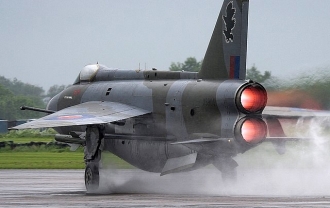 BLOODHOUND Tyres – with a previous user
BLOODHOUND Tyres – with a previous user
Good news on the wheels as well. The design for our runway wheels (which we will need first, for the UK runway tests next year) has been released to Castle Engineering. The tyres for the runway tests were originally designed for the Lightning jet fighter, but they happen to have the tall thin shape that we need.
We bought some unused tyres from the world’s last Lightning operator – Thunder City in South Africa. So we’ve shipped UK-made tyres back from South Africa, in order to test BLOODHOUND in the UK next year, before shipping it (still on these tyres) out to South Africa. It’s a funny world sometimes.
 Liquid Wheels
Liquid Wheels
The manufacturing process for the high-speed desert wheels has also been agreed with all the companies involved. The whole wheel manufacture process will involve some 4 tonnes of Aluminium, which Trimet is supplying in liquid form (did you know that aluminium is shipped as a liquid? No, me neither).
Otto Fuchs will then turn this large aluminium puddle into solid lumps (there are some technical terms involved like ‘casting’ and ‘forging’, but you get the general idea) from which we can machine the wheels.
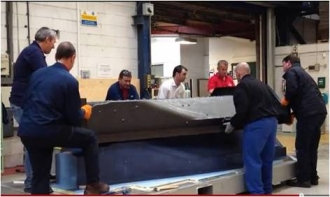 The lower cockpit mould is born
The lower cockpit mould is born
The carbon fibre monocoque work also continues, with the production of one of the cockpit moulds, which is now ready for work to begin on the cockpit lower section. It’s been a long time coming – can’t wait to see my 1000 mph office finally taking shape.
If you want to see how the whole process works, have a look at the latest Cisco BHTV video, ‘Carbon Fibre Monocoque’.
With the huge success of the Olympics only just behind us, we’re looking forward to creating another global British success in 2013/2014. The Olympics aimed to inspire a generation about sport, and of course to promote the team work and dedication that makes a successful sportsman. Look behind the science and technology of BLOODHOUND, and we are promoting exactly the same things – our engineers, and the hundreds of supporting companies, are the best in the world because they work hard at it, and they are building the world’s first 1000 mph Car together as a world-class team. The Olympics has done its bit, so now it’s our turn – and I can’t think of a better time to do it.


